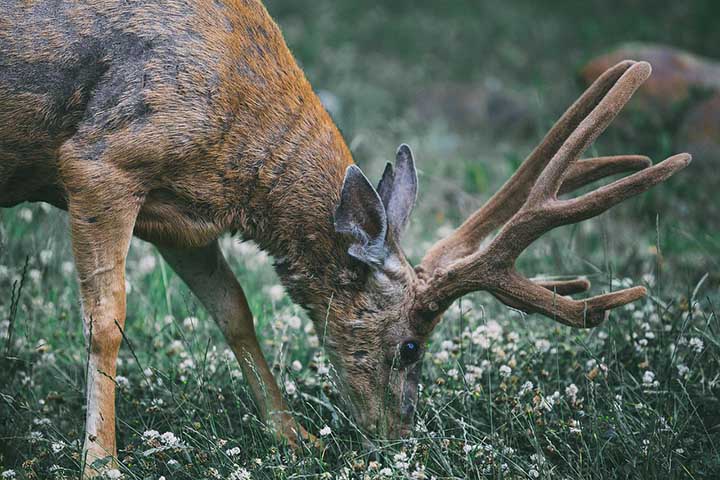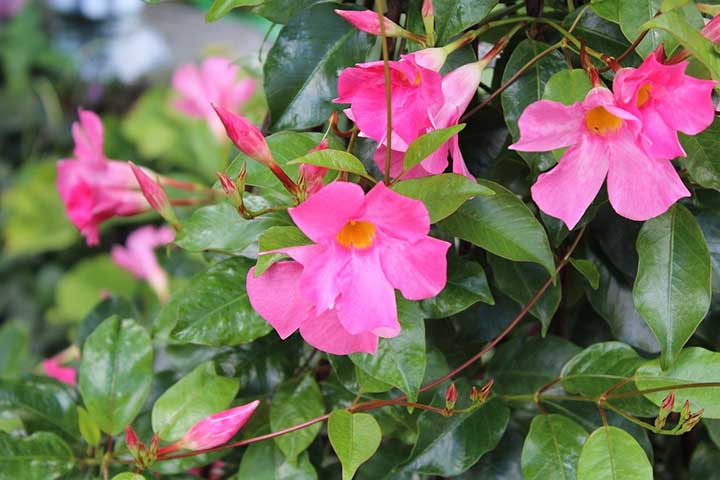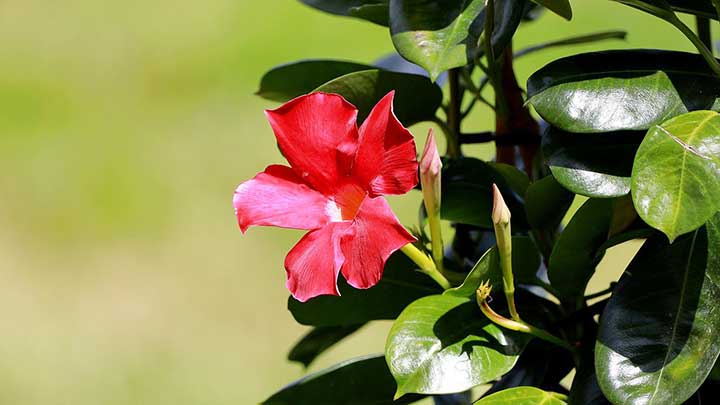Diplandenia and Mandevilla are two different yet highly similar blooming vine flower species that are often mistaken for each other.
But, are they deer resistant? Read on below and find out!
Table of Contents
What Does It Mean Deer Resistant in Plant?
When a plant is deer resistant, it does not become bulletproof, or tooth and hoove proof for that matter.
Deer-resistant plants, by definition, are less likely to be bothered by deer… but, they are not 100 percent resistant to deer by any means.
Typically, when a plant is considered “deer resistant” it has one or more qualities that make it less desirable to deer and other pests that would otherwise feed on it as a source of fiber and/or nutrients.
Most of the time, it is a strong and pungent aroma that the deer dislike about resistant plants, other times, as in the case of both Dipladenia and Mandevilla, it is a thick and bitter-tasting sap that keeps the pests from dining on it.
Sometimes it is the structure of the plant itself that makes it deer resistant, such as trees and shrubs once they develop hard and inedible bark or cactus which are too prickly for good eating.
Are Dipladenia and Mandevilla Deer Resistant?
Dipladenia and Mandevilla are both rather deer-resistant flower species, thanks to their strong scent and thick bitter sap/milk that deer seem to be disgusted with.
That means you can plant your Dipladenia or Mandevilla in and among other crops that are less deer resistant to boost their chances of survival.
This practice of using Mandevilla and/or Dipladenia as barriers to deer is similar to how gardeners use marigolds and basil plants as pest control for insects.
Between the smell of the leaves, sap/milk, and flowers, as well as the disgusting taste (to deer), you won’t have much to worry about in regards to deer and other mammals munching on or destroying your Mandevilla and Dipladenia.
Why Deer Do Not Like Dipladenia and Mandevilla?
Deer dislike different plants for a wide variety of reasons, including your flowering Dipladenia and Mandevilla plants.
Deer are apparently disgusted with at least three aspects of Dipladenia and Mandevilla plants:
- They can not stand the taste of the thick and bitter sap/milk produced by the plants’ central stalk and leaves
- The smell of the blooms/flowers isn’t attractive to deer as other sweet-smelling flowers are
- Both of these species grow on vines, and neither one looks as visually appealing to deer as softer more munchable flowers do
Everything considered the Mandevilla and Dipladenia are among the safest/most deer-resistant flowers you can successfully grow in your yard.
When Deer May Eat Dipladenia and Mandevilla?

Mandevilla and Dipladenia are rarely ever eaten by deer, rabbits, and other small game/pests that typically bother garden variety fruits, vegetables, and flowers.
Again, this is due to the rather disgusting milky sap that courses through the veins of the Dipladenia and Mandevilla vining flower plants.
The smell of the plants is another major deterrent to pests.
If deer and rabbits are completely starving and are on the edge of collapse, and happen to run across your Dipladenia and Mandevilla while they are in a state of delirium, that’s about the only time they’ll even consider eating it.
Most deer would rather try to eat some dried roots and dirt than fool with your disgusting Dipladenia or Mandevilla plants.
What Are the Best Ways To Protect Dipladenia and Mandevilla from Deer?
There are several ways that you can take extra precautions to ensure that your Dipladenia and Mandevilla plants are nearly fully resistant to deer:
Use deer fence
A deer fence is a liquid product that you may use to create an “invisible” barrier of protection around your yard, garden, or flowerbeds.
These products are easily found online, or in location gardening centers.
Spray the plant with deer repellent
Deer repellent works in a similar fashion to deer fence. However, it offers protection to the sprayed area, rather than creating a fence-like barrier or border.
All you have to do is spray the plant and the ground around it, and deer will stay away.
Plant them indoors
If you aren’t trusting in deer fence and deer repellent type products, and you already know there are deer in the area terrorizing flower beds, growing your plants indoors is a suitable option.
Indoors, your plants will be far and away from harm.
Plant them somewhere far from deer
Another option, besides planting them indoors, is planting them somewhere else that is far from deer.
Balconies raised beds in fenced areas, porches, and greenhouses are just a few options.
Surround them with more deer-resistant plants
Planting basil, lavender, marigolds, or other well-known deer-resistant plants around your Dipladenia and Mandevilla is another good way to make sure your flowers are completely deer resistant.
Do Deer Eat These Part of Dipladenia and Mandevilla?

Below, we discuss about each part of the Dipladenia and Mandevilla plants, and where or not deer eat them.
Leaves
The leaves of the Dipladenia and Mandevilla plants are ripe with a milky sap-like substance that runs through them. Deer can smell this substance, and they do not like it.
They also do not like the way it tastes. For these reasons, deer do not eat the leaves of Dipladenia and Mandevilla very often.
Flowers
The flowers of the Dipladenia and Mandevilla vines may be eaten by deer that are on the cusp of starvation.
The bright colors of the flowers may draw in a deer that is lacking nutrients, hoping that it is something good.
Bush
The foliage of both Dipladenia and Mandevilla are not much preferred by deer, thanks to the sticky, smelly, disgusting tasting sap/milk inside of its stalk, stems, and leaves.
Most of the time, deer wouldn’t eat either one of these plants even if they were starving (so long there is any other plant around).
Do Deer Like to Eat These Types of Diplanenia and Mandevilla?
Mandevilla Vine
Deer don’t like to eat Dipladenia or Mandevilla, period. That includes the vine-type species, which are among the most popular to plant in homes and gardens.
Mounding Mandevilla (mound-shaped Mandevilla)
The mound-shaped Mandevilla species, or mounding Mandevilla, are also safe from deer for the most part.
Unless a deer is on the brink of collapse due to starvation it is not likely to mess with your mounding Mandevilla plants.
Mandevilla Laxa
The species known as Mandevilla Laxa is another popular one, and it is just as deer-resistant as all the other Mandevilla and Dipladenia species.
That said, it wouldn’t hurt to plant these around other deer-resistant plants just to make sure they are left alone.
Yellow/ Red Mandevilla
Yellow and Red Mandevilla may be attractive visually, to deer and other pests, but once they get a bit closer (close enough to smell it) they are likely to change their mind and try munching on something else.
Again, planting with marigolds, or another pest-resistant flowering plant like Lavender, for example, is a great way to ensure the safety of your plants.
Sun Parasol Mandevilla
A gorgeous red flowering version of Mandevilla made famous in Japan (as it looks like the red sun on the Japanese flag), the Sun Parasol is as deer resistant as it is beautiful.
For the most part, deer won’t even dream about munching this plant. In the case they are on the verge of dying from lack of nutrients, they may make an exception.
Rio Dipladenia
The Rio Dipladenia is another vivid red species of Dipladenia that robust and easy to care for.
One of the best features of the exotic-looking Rio Dipladenia is that it is just as deer-resistant as the other species of Dipladenia and Mandevilla.
Q&A:
Do Squirrels Eat Mandevilla?
Squirrels do not typically eat Mandevilla because of all the same reasons deer and rabbits don’t eat the plant: it doesn’t smell good to them, and it tastes even worse if they do venture to try a bite.
Do Rabbits Eat Mandevilla?
Not even rabbits like to eat Mandevilla and will avoid it altogether if at all possible. It is the same story; they don’t want any part of the plant’s stinky milk and bitter-tasting plant matter.
Do Rabbits Eat Dipladenia?
No, rabbits do not eat Dipladenia. Like with deer, and squirrels, the milky substance in the plant’s veins is enough of a deterrent to keep rabbits from bothering it.
